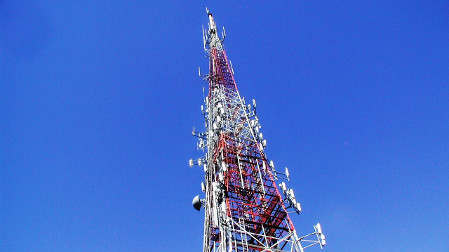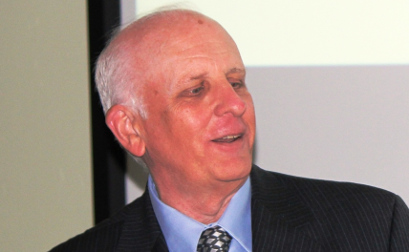Border Interference Issues Could Cloud Repack
ALEXANDRIA, VA.—The U.S. incentive auctioning of television broadcast spectrum has been shrouded in uncertainty ever since it got underway, with broadcasters and others expressing a growing list of concerns. However, there is one item that hasn’t received a lot of attention—the potential of RF interference to both repacked TV operators and wireless broadband operations from Canadian and Mexican television stations.

Can U.S. DTV and wireless broadband co-exist with transborder broadcasters in a repacked world? PHOTO CREDIT: Peter Starke, American Tower Corp.
Although the FCC developed software for modeling repacking scenarios on a market-by-market basis (including potential for both TV station interference and impairment to blocks of 600 MHz spectrum cleared for auction), and contends that the potential for interference is very low in border markets, there are skeptics.
“It would be nice if Canada and Mexico would fall in line with the repack in a timely way,” said Chares W. (Charlie) Rhodes, long-time TV Technology columnist and a recognized industry expert in interference issues. “However, the last thing that either country would stand is for the United States to dictate TV coverage in their countries, especially if there is no ‘quid pro quo,’ and right now there isn’t any. Memorandums of understanding between countries don’t mention compensation, and it’s not the usual practice in situations like this to give without taking.
“This is one of the items that I think may be unresolved in this auction,” Rhodes continued. “The FCC is being very close-mouthed about it and the Department of State has said nothing. There are a whole bunch of issues, any one of which could delay the availability of spectrum for stations along the border to shift frequencies.”
NO INCENTIVE
Rhodes’ concerns were echoed by Bill Meintel, senior partner at the RF consulting firm, Meintel, Sgrignoli, and Wallace.
“There’s no incentive for the Mexican and Canadian stations to move unless their governments force them to, but I doubt if this would happen,” said Meintel. “On the other hand, it could come down to the wireless carriers putting up money for such moves.”
Get the TV Tech Newsletter
The professional video industry's #1 source for news, trends and product and tech information. Sign up below.
Meintel said that he had television clients in border areas that could be impacted, but it was too soon to know if they might face interference problems.

Bill Meintel
“You’re not going to know what the situation will be until you know what channel they’re going to land on,” he said. “My understanding is that the FCC is going to use the scheme in the 2014 Report and Order to determine if they can use particular channels. They’re going to look at a station’s existing service in 2012 as the baseline. There has to be a reasonable effort to maintain this coverage. They will look at the points where service exists now that’s not impacted and then look at how much interference this new entry will cause, and they’ll allow up to one-half of a percent new interference. I think there is potential for additional interference, because each evaluation is one-on-one.
“My concern is that if they start having problems trying to make this work in getting the amount of spectrum they want, they may renege on this half-percent interference,” Meintel continued. “They could claim that it’s in the public interest to allow more interference so there can be more spectrum for wireless broadband. We’ll see how this all goes, but I’m skeptical.”
NAB SEES POSSIBLE CHALLENGES
Dennis Wharton, executive vice president of communications for the National Association of Broadcasters, was asked to share his thoughts on possible cross-border interference issues.
“Throughout all of the [spectrum auction] discussions, all stakeholders have identified border areas as areas of complexity,” said Wharton. “There is no mechanism in place for funding moves in [Canada and Mexico] and no timeline. We can’t predict when this will happen. We really have no position on this, other than it could potentially pose challenges, but it is up to broadcasters in those countries to move.”
Wharton praised the FCC for their work in obtaining the agreements for cooperation that are now in place and noted that the NAB had worked with the FCC in setting up methodologies for predicting interference cases and reiterated the commission’s pledge to U.S. broadcasters.
“The FCC adopted a zero interference policy for broadcasters; they can’t be interfered with.”
WIRELESS BROADBAND INTERESTS FACE PROBLEMS
It’s not just U.S. broadcasters who harbor concerns; telcos could face some thorny issues too.
“The broadband people have told the FCC that there are problems, but the FCC said ‘no, our computer modeling says otherwise,’” said Rhodes, noting that he’s measured interference thresholds to wireless broadband services from television stations and it’s far from zero, and that such warnings have been published in ITU proceedings, but ignored by the FCC.
Rhodes observed that wireless networks would likely have coverage holes if Canadian and Mexican broadcasters don’t follow suit with those in the U.S. in repacking.
“Who is going to want a mobile phone that doesn’t play anywhere and anytime?” Rhodes mused. “This doesn’t happen now, but the situation will be quite different when interference sources are megawatt ERP TV transmitters. However, the FCC continues to push forward with a ‘whatever happens, happens’ attitude.
“I believe that the broadband interests are going to be very hesitant about committing money for spectrum if they don’t know when they’re going to get to use it,” Rhodes continued. “The FCC needs to resolve this before the auction. Telco managements will need to know when the spectrum will be available.”
In accordance with spectrum auction confidentiality, wireless broadband service providers are not allowed to comment publically about the auction; however, some are voicing concerns about unresolved interference issues. One member of the wireless industry, speaking under conditions of anonymity, stated that while there were agreements in place between respective governments, “the challenge is that there is currently no timeline, nor any reimbursement funds for TV station moves in Canada and Mexico,” and noting additionally that Mexico’s refusal to adopt the U.S. band plan will further complicate matters.
“If Canada and Mexico do not timely move, border markets will remain impaired, so we anticipate that there will be continuing challenges at the border,” the source said.
IS THERE A WORKAROUND?
Meintel related that an interference “solution of sorts” was achieved following a wireless carrier’s purchase of TV Channel 52 spectrum and the recognition of potential interference issues with Channel 51 broadcasters.
“The concern was not so much that they would be interfering with TV stations, but that TV stations would be interfering with them,” said Meintel. “Technically, they had to protect the television station’s service contour, which meant they couldn’t operate inside it and the market they wanted to cover was the same as the TV station’s. The only way they could operate was to get stations to accept the interference potential. This happened in a number of situations. The stations figured that they were reaching enough people on cable and were OK with the interference potential if the wireless broadband company was willing to write a check.
“On the other hand, there were stations who not only said no, but ‘hell no!’”
